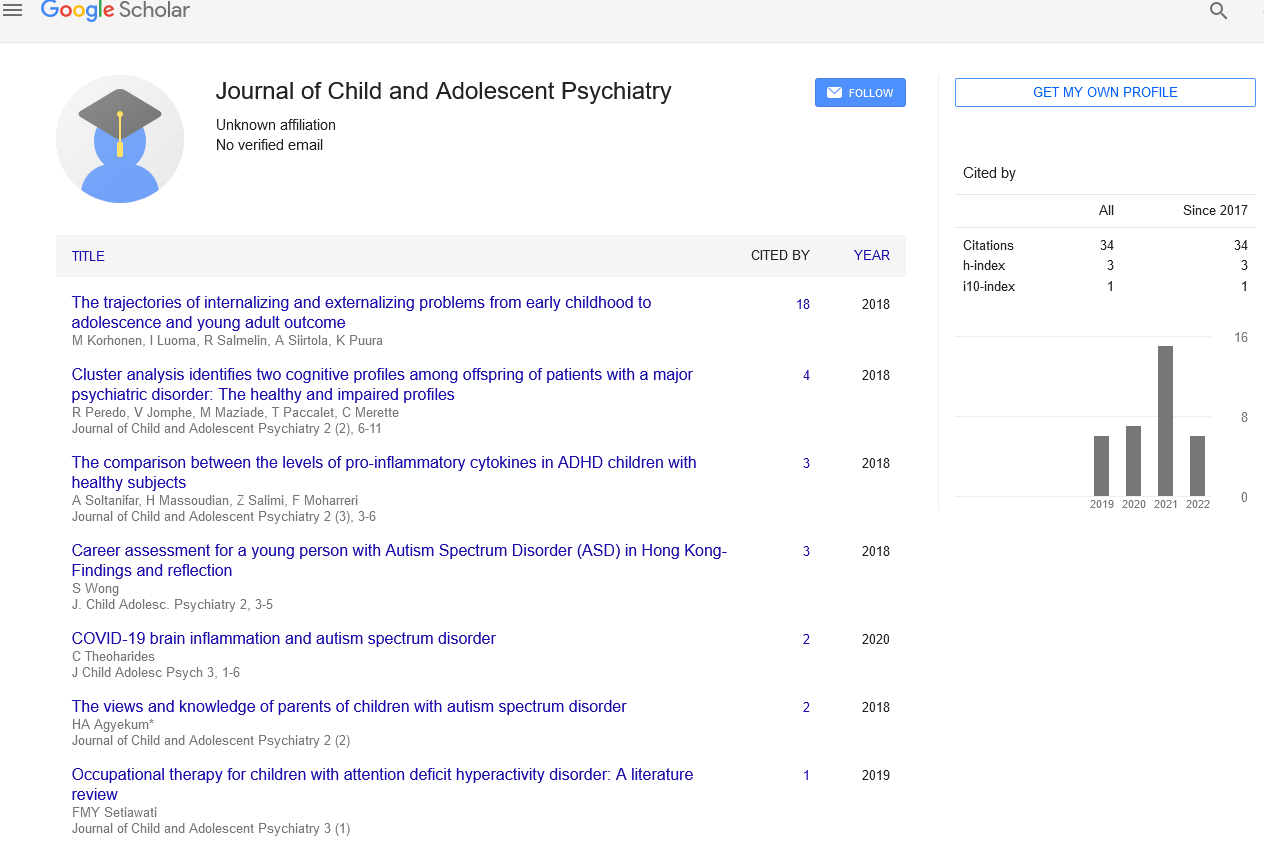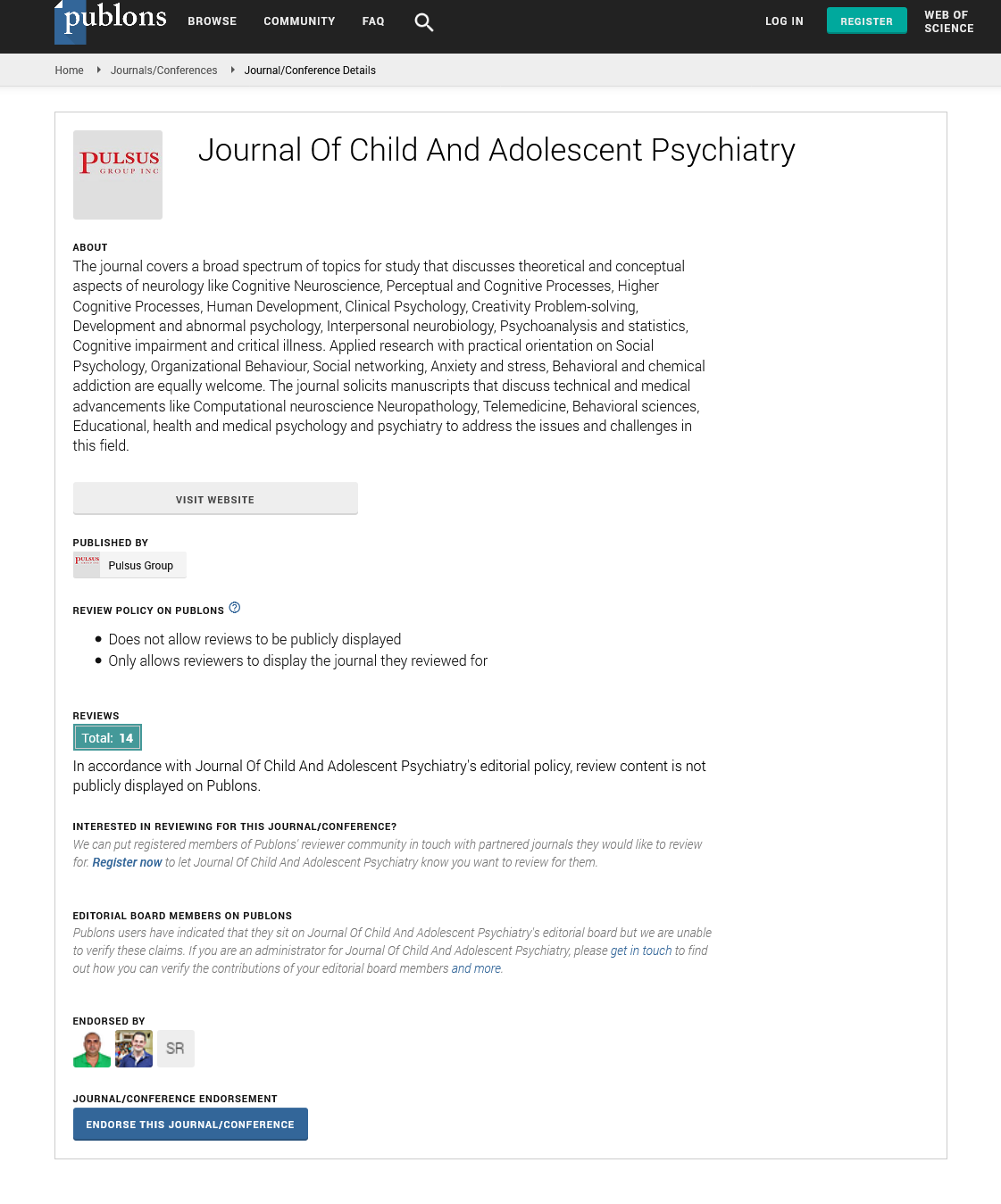Perspectives of the Adolescents and Their Parents on Multifamily Therapy for Adolescents With School Refusal
Received: 04-Nov-2022, Manuscript No. puljcap-22-5939; Editor assigned: 12-Nov-2022, Pre QC No. puljcap-22-5939 (PQ); Accepted Date: Nov 26, 2022; Reviewed: 16-Nov-2022 QC No. puljcap-22-5939 (Q); Revised: 27-Nov-2022, Manuscript No. puljcap-22-5939 (R); Published: 27-Nov-2022, DOI: 10.37532/puljcap.2022.7(1);01-02.
Citation: Clemens A. Perspectives of the adolescents and their parents on multifamily therapy for adolescents with school refusal. J Child Adolescence Psychiatry. 2022; 7(1):01-02.
This open-access article is distributed under the terms of the Creative Commons Attribution Non-Commercial License (CC BY-NC) (http://creativecommons.org/licenses/by-nc/4.0/), which permits reuse, distribution and reproduction of the article, provided that the original work is properly cited and the reuse is restricted to noncommercial purposes. For commercial reuse, contact reprints@pulsus.com
Abstract
In adolescent psychiatry, school refusal has become a significant public health concern. In France, it accounts for 5% of child and adolescent psychiatry consultations. In the past 30 years, multifamily therapy has evolved. In adult, child, and adolescent psychiatry, as well as for kids who run the danger of being excluded from school, its effectiveness has been proven. In this study, we used a qualitative method to investigate how teenagers and their parents experienced a multifamily therapy treatment for school refusal
Key Words
Functional motion disorders
Introduction
School refusal is a current, global public health problem. It has become more prevalent in recent years and accounts for 5% of psychiatric visits in preadolescence and adolescent in France. School refusal is unique from other types of School Attendance Problems (SAP), such as truancy, school withdrawal, and school exclusion, and was first referred to as "school phobia" by. Reasons and motivations for skipping school are vary in truancy (positives rewards).
There is no anxiety, and parents are typically not informed of absences. Young people are reluctant to attend school. Finally, behavioural problem and oppositional defiance disorder are more frequently linked to truancy as well as expulsion from school. Berg's consensus-based international definition of school refusal is based on the following four criteria. In addition to emotional distress that is temporary and indicative of aversion to attendance (excessive fearfulness, temper tantrums, unhappiness, unexplained physical symptoms, etc.) or emotional distress that is chronic and impeding attendance (depressive affect; sleep issues, for example), the young person is reluctant or refuses to go to school. Absence is the most common but not always present manifestation of these symptoms (e.g. late arrivals; missing whole school days; missing consecutive weeks, months, or years).
Since they are at home and their parents are aware of it, the young person does not try to disguise the absence from their parents, and if they had previously done so, they stopped once the absence was detected. Beyond refusing to accompany their parents when they try to enrol them in school, the young child does not exhibit serious antisocial behaviour. The parents have made reasonable steps to ensure attendance at school, either recently or in the past, and/or they have stated their goal for their kid to attend school full-time. To evaluate school rejection, it's critical to consider if parents have made reasonable efforts.
The underlying social and educational concerns at play are not addressed by either the DSM-5 (Diagnostic and Statistical Manual of Mental Disorders) or the ICD-10 (International Classification of Diseases).
First-grade classrooms and adolescence were the two main age groups where school rejection was most prevalent. Adolescents appear to have a higher prevalence than children. There is no gender, socioeconomic, or intellectual difference in prevalence. Somatic complaints account for half of all school refusals (headaches, abdominal pains, nausea, sleeping disorders).
Refusal to attend school has various co-morbidities. Anxiety and depression disorders affect 50% of patients. Poor academic performance (31%), negative effects on peer relationships (34%), family problems (43%), school leaving (25%) alienation from peers, dangerous behaviours (Addiction), and suicide attempts are among the short-term effects. Anxiety, depression, and personality disorders are still present in 30% to 50% of these adolescents as adults. They have fewer children, spend more on psychiatric care, spend more time at their parents', and experience more professional failure. As a result, according to some authors, returning to school is merely one predictive factor among others when considering a person's capacity for general adaptation .
As a result, school refusal is a serious problem that requires immediate attention. The prognosis depends on how much school the child misses, and early intervention is necessary. The return to school is the first goal. Adolescents may benefit from outpatient care, a day hospital, or a full hospital stay depending on the severity of their school refusal. The care is interdisciplinary. The suggestion of individual psychotherapy is made frequently; cognitive-behavioral therapy (CBT) has produced effective results . Anxiolytics or antidepressants are suggested as medication when necessary. Working with schools and families is also crucial.






